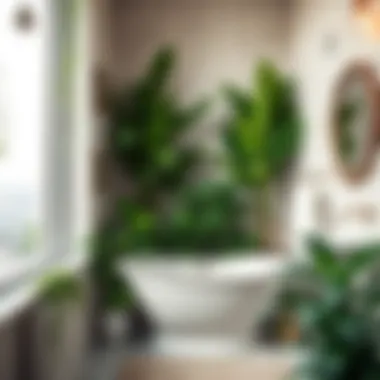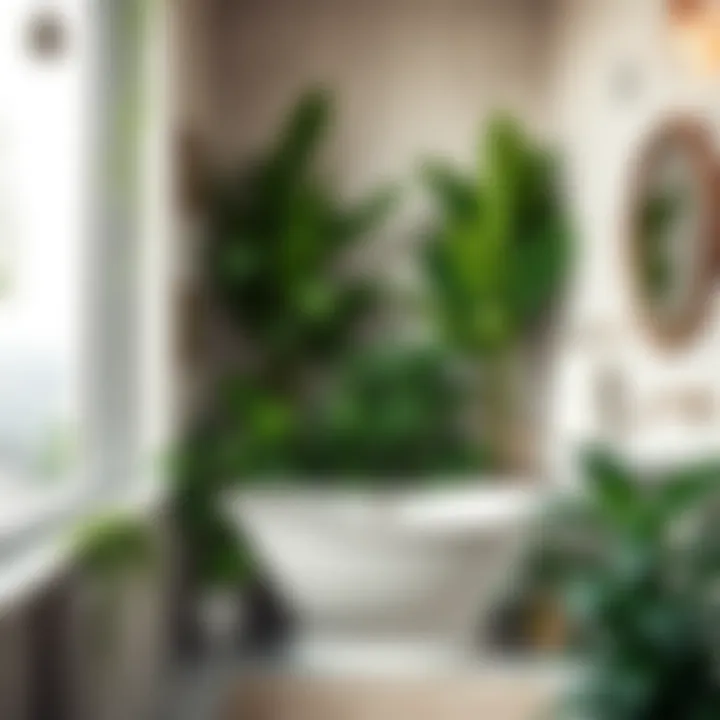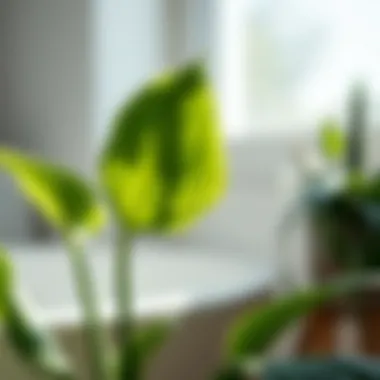Best Plants to Enhance Your Bathroom Experience


Intro
Choosing plants for your bathroom can transform this often-overlooked space into a vibrant oasis. But not all plants thrive in the unique conditions found here. Bathrooms usually exhibit high humidity and varying light levels which can pose challenges for certain species. This guide will explore the ideal plant selections for creating a revitalizing atmosphere and will focus on factors like humidity, lighting, and aesthetic appeal.
Understanding the interactions of these conditions is crucial when picking plants that not only survive but flourish, contributing positively to your space. Homeowners and renters alike can cultivate a harmonious bathroom environment that melds beauty with practicality. Let's delve into trending styles and color palettes to fully articulate how you can achieve this.
Trending Styles
Modern Minimalism
In today’s fast-paced world, many are leaning towards modern minimalism, where less truly means more. This style emphasizes a clean and uncluttered aesthetic, focusing on simplicity and functionality. In this context, plants with sleek lines are favoured.
- Snake Plant: Known for its architectural shape and resilience. Thrives in low light with minimal watering.
- ZZ Plant: This hardy plant tolerates neglect, fitting the minimalist mantra perfectly.
- Peace Lily: Not just pretty, this plant can purify bathroom air with its white flowers and rich green foliage.
By choosing plants like these, the bathroom gains a touch of nature without excessive maintenance. Keep them potting in simple, geometric containers to echo that streamlined design.
Cozy Rustic
On the flip side, some may prefer a cozy rustic vibe, where warmth and charm are prioritized. This style emulates a quaint cottage atmosphere, decorated with natural textures and materials that harmonize with the outdoors.
- Pothos: Aloe vera is a great choice, trailing beautifully from shelves or hanging baskets.
- Spider Plant: Its arching, variegated leaves offer a welcoming feel and adapt well to bathroom conditions.
- Boston Fern: This lush, feathery plant thrives in humid environments; it needs attention but rewards you with its beauty.
The earthy tones of the pots used for these plants enhance the rustic theme, complementing the overall warmth that the space invites.
Color Palettes
Calming Neutrals
When it comes to color, calming neutrals are perfect for establishing tranquillity. Shades like beige, soft gray, and warm whites can create a serene backdrop against the rich green of bathroom plants, allowing for a harmonious blend.
In this palette:
- Bamboo Palm: Adds a tropical touch while blending seamlessly with neutral tones.
- Dracaena: Varieties with muted foliage can soften sharp angles and create a spa-like appeal.
Tip: A pot in a similar neutral color to the wall will make the plants feel as if they belong, enhancing the relaxed atmosphere.
Bold Accents
For those keen on making a statement, bold accents can invigorate your bathroom space. Bright pots or vibrant foliage can disrupt the monotony and add character.
Consider:
- Fiddle Leaf Fig: A striking addition with large leaves that draw the eye.
- Bird of Paradise: Its unique form and vibrant green can introduce a tropical element.
Combining these colorful pots against a textured bathroom backdrop can amplify this energetic approach, giving the room a spirited identity.
Selecting plants that fit your bathroom’s unique conditions brings life and vibrancy while enhancing the overall aesthetics.
To wrap it up, tailoring your plant selection to these styles and palettes can create an inviting environment, ensuring your bathroom is much more than just a functional space. Whether you go for sleek minimalism or embrace rustic coziness, finding the right plants will make all the difference.
Understanding Bathroom Conditions
When it comes to selecting plants for your bathroom, comprehension of the specific conditions that prevail in this space is crucial. Unlike other rooms in your home, bathrooms are often compact, with fluctuating levels of humidity and light as well as unique temperature changes. Understanding these conditions informs your choices and ensures that your green friends thrive in their new environment.
Humidity Levels
Humidity plays a significant role in plant health, especially in bathrooms where moisture tends to be higher than in other areas. A steamy shower or long hot bath can create a humid atmosphere that some plants adore. Species such as the Peace Lily thrive in these damp conditions and can filter out pollutants as they bask in the moisture.
Higher humidity means you can say goodbye to wilting leaves; this adds an extra layer of resilience to the plants in your bathroom. However, it’s also essential to watch for fungal growth, which can arise in excessive humidity. A little balance goes a long way here.
Light Availability
Light in bathrooms often comes in limited bursts, with windows sometimes blocked or absent. Observing how much natural light enters your bathroom is a game changer when choosing plants.
If your bathroom has a lot of light, you can venture into species that require more sunshine, such as succulents and cacti. On the other hand, if your bathroom is dark, consider low-light champions like the ZZ Plant or Snake Plant.
To maximize the light your plants receive, try placing them near mirrors or reflective surfaces. This trick can help spread the illumination without needing a sunlit window. Keep in mind, plants that can adapt to low-light conditions often exhibit an elegant can-do attitude.
Temperature Fluctuations
Temperature in bathrooms can be akin to a rollercoaster ride, especially during seasonal changes. Heated showers can send the mercury soaring, while cold drafts from windows can drop the temp in the blink of an eye. Many plants, such as ferns, flourish in stable but slightly warmer environments, while others are tougher and can withstand more drastic swings.
Paying attention to how hot or cold your bathroom gets can help in selecting plants that’ll be right at home. You wouldn't want your plants to end up feeling like they’re on a constant pilgrimage through Mother Nature’s whims.
"Knowing your bathroom's conditions is half the battle; the other half is ensuring your plant choices are wise and deliberate."
By truly understanding the conditions in your bathroom, you’ll be in a prime position to curate a green oasis that’s both beautiful and nourishing to the air you breathe.


Benefits of Having Plants in the Bathroom
In recent years, there has been a noticeable uptick in the popularity of incorporating plants into bathroom spaces. But why exactly is this trend taking root? The benefits of having plants in the bathroom extend beyond mere aesthetics; they intertwine with the very fabric of our everyday living environment. It boils down to three core advantages: enhancing air quality, elevating the visual appeal, and regulating moisture levels.
Air Quality Improvement
One of the most compelling reasons to introduce plants to your bathroom is their ability to act as natural air purifiers. Various species of houseplants have been shown to absorb toxins and improve indoor air quality. While most people might not realise it, our bathrooms can harbor unpleasant odors and volatile organic compounds (VOCs) that come from cleaning products and other materials.
Plants like the Snake Plant and Peace Lily thrive in humid conditions and can effectively remove pollutants such as formaldehyde and benzene. These plants not only absorb carbon dioxide to release oxygen, they also increase humidity by releasing moisture through a process called transpiration. This dual role of improving overall air quality while keeping the bathroom's microclimate pleasant is significant for promoting a healthier living space.
"Incorporating green plants can increase humidity and reduce dust, creating a fresher atmosphere that benefits both mind and body."
Aesthetic Enhancement
There is little doubt that plants can elevate the look and feel of any room, and the bathroom is no exception. Plants add a splash of color and natural texture, transforming a sterile space into a serene oasis. Imagine walking into a bathroom adorned with lush greenery, complemented by warm wooden accents and soft lighting. It's a small detail that can have a monumental impact.
When choosing plants specifically for aesthetics, consider varieties like Orchids or Bamboo which not only look elegant but also fit harmoniously into the tranquil vibe you want to create. Different pot styles—rattan, ceramic, or even hanging baskets—can further enhance this aesthetic appeal. By thoughtfully placing plants, you add vibrancy to spaces that might otherwise feel clinical or uninviting.
Moisture Regulation
Another significant advantage of bathroom plants is their role in regulating moisture levels. Bathrooms are naturally humid environments, especially post-shower when steam fills the air. While this humidity can lead to issues like mold growth, certain plants can help maintain optimal moisture levels.
For instance, the Spider Plant thrives in humid conditions and can absorb excess moisture from the air. This helps keep the bathroom environment balanced, preventing mold and promoting a healthier space. Furthermore, having plants that enjoy this level of humidity can also reduce the overall workload of household dehumidifiers or ventilation systems.
In summary, integrating plants into your bathroom goes beyond just decor. It's about creating a harmonious space that supports healthy living, enhances your environment, and fosters a sense of well-being. Why not let nature take root in your home?
Choosing the Right Plant Types
Picking the right plant for your bathroom isn’t just about aesthetics; it’s essential for creating a thriving environment. Bathrooms are unique spaces, characterized by fluctuating humidity and varying light conditions. Thus, understanding which plants will flourish in such an environment can make all the difference. The right choice can transform your bathroom into a vibrant oasis, offering both beauty and practicality. With the different factors unique to a bathroom in mind, let’s look more closely at some specific types of plants best suited for these conditions.
Low Light Tolerant Plants
Snake Plant
The Snake Plant, often known as Sansevieria, is nearly legendary for its resilience. It thrives on neglect, making it a perfect fit for bathrooms that might not have the brightest light. Its tall, upright leaves convey a sense of elegance while efficiently filtering air pollutants. This plant offers a unique characteristic: it converts carbon dioxide into oxygen at night, which is rather uncommon among indoor plants. Despite these qualities, one should note that overwatering can lead to its swift demise, so a careful balance in watering is critical.
ZZ Plant
The ZZ Plant, also referred to as Zamioculcas zamiifolia, stands as a testament to durability. Its glossy, dark green leaves add a striking contrast within a typically chill atmosphere of a bathroom. Another bonus is its ability to endure low light and irregular watering, making it a favorite among busy homeowners. Its unique adaptation allows it to store water in its thick stems, ensuring it can withstand periods of drought. However, care should be taken; this plant can be toxic if ingested, making it less ideal for homes with curious pets or children.
Pothos
Pothos, or Epipremnum aureum, is an absolute crowd-pleaser for various spaces, including the bathroom. Its trailing vines can gracefully hang or climb, adding movement and life. The plant thrives in a wide range of conditions, but it truly speaks to the humid environment of a bathroom. A key trait of Pothos is its air-purifying properties; it’s like having a little green air purifier. On the downside, it does need occasional trimming to prevent it from taking over your décor.
High Humidity Favorable Plants
Boston Fern
Known for its lush foliage, the Boston Fern prefers a moist environment, making it an ideal companion for any bathroom. This plant excels at absorbing humidity, which not only benefits its growth but the air quality in your space as well. A noteworthy aspect of the Boston Fern is its ability to remove toxins like formaldehyde from the air. However, it does require regular misting and can be quite picky about its light sources.
Peace Lily
The Peace Lily, with its elegant white blooms, offers more than just good looks. It can thrive in high humidity environments and also boasts impressive air-purifying capabilities. An essential selling point of Peace Lilies is that they can flourish in low-light conditions, which is a significant asset for many bathrooms. That said, they are sensitive to direct sunlight and require consistent watering to maintain their vibrant appearance. The downside? The plant is toxic when ingested, so caution is necessary if you have curious pets or kids.
Spider Plant
The Spider Plant is as hardy as it is attractive. Known for its distinctive arching leaves and spider-like offshoots, this plant thrives on humidity and indirect light. One of its standout features is its ability to bounce back even when neglected. Spider Plants also efficiently filter indoor air pollutants. They do need occasional repotting, but they are widely regarded as beginner-friendly.
Compact Plants for Limited Spaces
Succulents
Succulents are the quintessential choice for compact spaces. Their thick, fleshy leaves are designed to retain moisture, making them well-suited for environments where less humidity is present, but they can adapt to bathrooms that have some humidity too. They come in various shapes and sizes, which allows for creative displays in limited areas. However, too much moisture can wreck havoc on these beauties, leading to rot. So, drizzling water sparingly is crucial.
Cacti
Cacti provide a striking visual punch even in the tiniest bathroom corners. They're low-maintenance because they thrive on infrequent waterings. Besides, they come with a quirky personality that makes them a fun option. The challenge, however, is their dislike of excessive humidity, which makes placement crucial. If your bathroom tends to be steamy, keep them far from the showers.
Air Plants
Air Plants or Tillandsia offer a unique growing method, simply drawing moisture from the air around them. They don't require soil, making them extremely versatile in how they can be displayed. You can attach them to driftwood or keep them in whimsical terrariums. They enjoy high humidity, a perfect match for any bathroom setting. Just remember, they need a bit of misting or soaking to thrive. As easy-going as they might be, they can dry out quickly if neglected.
Care Considerations for Bathroom Plants
Caring for plants in the bathroom is not as simple as just plopping them down and giving them a drink here and there. The bathroom environment carries its own unique challenges, and understanding these can mean the difference between a thriving green companion and a sad, wilting pile of leaves. By honing in on the specific care considerations—like watering needs, soil requirements, and fertilization practices—homeowners can cultivate a flourishing indoor oasis that enhances their well-being and bathroom aesthetics.
Watering Needs
Watering is a delicate balancing act, especially in a setting as humid as a bathroom. While some plants love to soak it up, others wilt at the thought of over-saturation. Generally, the higher the humidity, the less often you need to water your plants. Bathrooms provide a natural moisture-rich environment, making it easy to misjudge how much water a plant truly needs.


To navigate this, it's smart to check the soil moisture before reaching for your watering can. Stick your finger into the soil about an inch deep; if it feels dry, it’s time for a drink. Alternatively, a moisture meter can give you a more precise reading. Keeping a consistent watering schedule can be tricky, but it’s vital to ensure your plants get just the right amount—never too soggy, never too parched.
Soil Requirements
The right soil is a foundational aspect of successful plant care. Given that bathrooms can be humid, potting soil must be breathable yet retain moisture. A good mix consists of potting soil combined with perlite or coconut coir, which promote aeration while allowing moisture retention.
Different plants might have varying preferences—pothos may thrive in a lighter mix, while a snake plant often leans toward something denser. If you're planting something like a Peace Lily, look for a soil blend that offers good drainage to avoid stagnant water that can lead to root rot. Proper soil not only helps with drainage but also delivers the essential nutrients that plants thrive on.
Fertilization Practices
Even though bathroom plants might seem self-sufficient, they do appreciate a well-timed nutrient boost now and then. Fertilization is crucial, particularly during the growing season—typically spring and summer. Using a balanced liquid fertilizer diluted to half strength can encourage healthier growth without overdoing it.
Most plants can get what they need with a feeding every four to six weeks. However, it's important to note that some plants are more sensitive to fertilizers than others, so erring on the side of caution when introducing nutrients is wise. Always pay attention to your plants' responses; if you notice any leaf discoloration or unusual growth patterns, adjust accordingly.
"Ensure at least one good care practice for bathroom plants, so they don’t just survive but actually flourish in their home."
Taking the time to understand and implement these care considerations can significantly impact the vibrancy and health of your bathroom plants. The right watering, soil, and fertilization practices create a nurturing environment that keeps plants lush and enticing, enhancing both the decor and atmosphere of your bathroom.
Top Plant Selections for the Bathroom
Choosing the right plants for your bathroom is not merely about filling a few pots with greenery; it’s about enhancing the microenvironment of this unique space. The bathroom offers a cocoon-like setting where plants can thrive due to high humidity and moisture levels, which can make them flourish. Moreover, certain plants provide various benefits—from purifying the air to adding an element of style and tranquility. Getting the plant selection right can elevate this room, turning it into a spa-like retreat.
Aloe Vera
Health Benefits
Aloe Vera is widely recognized not just for its appealing look but for its impressive health perks too. This succulent features fleshy leaves that contain a clear gel known to promote skin healing and hydration. It dazzles with the capability to soothe burns, cuts, and irritations, making it an effective home remedy for various skin ailments. In a bathroom, where moisture abounds, Aloe Vera feels right at home and adds a touch of natural wellness. The unique property of its gel enhances its status as a go-to plant in homes, making it a beloved choice among people who value both beauty and health.
Cultivation Tips
When it comes to cultivating Aloe Vera, simplicity reigns supreme. This shrub thrives in well-draining soil and needs little attention, making it a hassle-free pick. Since it prefers dry conditions, it’s essential to avoid overwatering it; letting the soil dry out between waterings should do the trick. Moreover, Aloe Vera loves bright indirect sunlight, which makes placing it near a bathroom window ideal. Its straightforward care can boost homeowners’ confidence, ensuring that even novice gardeners can enjoy its benefits without a hitch.
Bamboo
Symbolism and Care
Bamboo carries rich symbolism—often associated with luck, resilience, and tranquility. In many cultures, it's viewed as a representation of prosperity and growth. This fast-growing plant can reach impressive heights, which can create a striking visual in your bathroom. Caring for bamboo can be straightforward, as it often thrives in water rather than soil. However, too much direct sunlight can scorch its delicate leaves, so keeping it in a spot with indirect light is crucial. Incorporating bamboo into your bathroom not only uplifts the aesthetics but can be part of a larger symbolism of peace and well-being.
Placement Suggestions
To maximize the impact of bamboo in your bathroom, consider placing it near a source of light but out of reach of the sun's harsh rays. Ideally, a tall bamboo arrangement in a vase or container can create a natural divider between spaces or become a centerpiece on a shelf. It’s also advisable to position it where it can take advantage of the humidity that bathrooms typically provide, which allows it to thrive effortlessly. Using bamboo effectively can give your bathroom a more organic feel, making it an oasis of relaxation.
Orchids
Varieties Suited for Bathrooms
Orchids are often seen as the gems of indoor plants, prized for their diverse shapes and striking colors. Certain varieties, such as Phalaenopsis—often named moth orchids—are particularly well-suited to bathrooms. They thrive in the humid environment and can tolerate low light, making them a fantastic choice. Their long-lasting blooms can add a pop of color while enhancing the overall ambiance. These beauties can be a conversation starter while contributing to the visual appeal of your bathroom.
Maintenance Requirements
Maintaining orchids requires a bit more finesse than some other plants, but it’s not unmanageable. They prefer a bark-based potting mix, which allows for good aeration. Be cautious with watering; it's best to let the soil dry slightly between waterings. Light is also vital; they prefer indirect sunlight. Despite their reputation for being tricky, with the right care, orchids can flourish, making them worthwhile additions that reward you with their stunning blooms and enhance the bathroom's atmosphere.
"Plants can transform a simple bathroom into a serene sanctuary."
Designing with Plants in Mind
Integrating plants into bathroom design transcends mere aesthetics; it crafts an experience that envelops users in tranquility and connection to nature. Choosing the right plants can enhance the ambiance while also improving air quality and even humidity levels. As you step foot into a bathroom adorned with lush greenery, it invokes a sense of calm, akin to stepping into a mini-oasis. But how do we make this a reality? This section will explore important considerations to design a bathroom that harmonizes with plants.
Creating a Cohesive Look
A well-curated collection of plants can make a bathroom feel like a sanctuary. When selecting plants, it’s crucial to consider their color, texture, and size to create harmony within the space. For instance, if your bathroom tends to lean towards a minimalist style, opting for sleek and streamlined plants like the Snake Plant may enhance that theme.
On the other hand, if your aesthetic embraces richness, you might mix larger plants such as the Peace Lily with smaller succulents for visual balance. It’s a bit like assembling a wardrobe; each piece must complement the others, creating a unified appearance. Some practical tips include:
- Opt for consistent planter colors (white, black, or metallic) to amplify cohesion, and avoid overly distracting or multicolored pots.
- Mix varying heights by placing plants of different sizes on shelves or tables to draw the eye upward, which can trick the mind into perceiving a larger space.
- Consider common themes, such as tropical vs. desert plants, to ensure they all speak the same visual language.
Choosing Planters
Selecting the right planter is an essential part of showcasing your plants in the bathroom. The right container not only holds the plant but becomes part of the decor, melding with the overall design.
When considering materials, ceramic and terracotta pots work wonderfully in high-humidity environments as they can absorb excess moisture. On the flip side, plastic and fiberglass might be better for lighter conditions since they don’t weigh much and are easy to move.
Take into account the size of your plants and ensure that they have enough room for their roots to thrive. A pot that’s too small can stunt growth, while one that’s too large can lead to overwatering. Additionally, it might be wise to think about drainage. Good drainage is key to preventing overwatering—a consideration as crucial as selecting the plant itself.
Positioning for Impact
Placement of plants can dramatically transform a bathroom. Think of it as an art installation; it’s not just about filling spaces but enhancing them. For example, set a tall floor plant like the Bamboo in a corner to draw the eye, while smaller plants could rest on shelves or window sills.


Here are some effective strategies for positioning your plants:
- Near windows: Utilize natural light by placing light-loving plants like Orchids where they can soak up sun rays, promoting their health.
- On countertops or sinks: Plants such as Aloe Vera not only look attractive but give easy accessibility for their health benefits.
- Hanging plants: If space is limited, consider hanging your plants from the ceiling or wall. It adds dimension to the space and makes use of verticality.
"Plants can lift spirits, both literally and figuratively, creating a livable art piece that transforms the bathroom experience, grounding users with nature.��”
Explore more tips to enhance your bathroom with plants at Horticultural Society of New York and The Gardenista.
Common Challenges in Bathroom Plant Care
Maintaining a lush and healthy plant oasis in the bathroom can be a rewarding experience, but it also comes with its own set of hurdles. Understanding the common challenges in bathroom plant care is essential for those looking to keep their greenery thriving in this unique environment. Let’s explore crucial aspects which can affect your plant’s health and how to address them effectively.
Pests and Diseases
Indoor plants, much like their outdoor counterparts, can fall victim to pests and diseases. Bathrooms, typically warm and humid, can become a breeding ground for insects such as spider mites, aphids, and fungus gnats. These little critters not only damage the foliage but can lead to more significant issues if not caught in time. A common sign of pest infestation can be yellowing leaves or webbing on the plants.
To ward off these pests, regular inspections are vital. One useful tip is to maintain cleanliness around the plants, wiping leaves periodically. If you find pests, a gentle spray of insecticidal soap can effectively eliminate them. Also, introducing beneficial insects like ladybugs can create a natural balance, keeping pests at bay without harmful chemicals.
Overwatering Issues
When it comes to bathroom plant care, overwatering is perhaps one of the most prevalent issues. In a humid environment, water tends to linger around the roots longer, increasing the risk of rot. Many houseplants prefer to dry out a bit between watering, which can be tricky in a consistently moist atmosphere like a bathroom.
To avoid this pitfall, observe soil moisture before watering. Stick your finger about an inch into the soil; if it feels damp, hold off on watering. Furthermore, utilizing pots with drainage holes can allow any excess water to escape, helping the plant stay healthy. Additionally, consider using a moisture meter if you want to be precise.
Light Stress
Light in a bathroom can be a mixed bag. While some bathrooms may receive generous sunlight, others offer scant illumination, creating a challenging environment for light-requiring plants. Low-light species generally do well, yet even they can experience stress if they get too little light, leading to leggy growth or lackluster color.
The first step in addressing light stress is understanding your bathroom’s light conditions. Observe how much natural light enters throughout the day. For dimmer spaces, rotating plants often between sunnier rooms can help, or investing in grow lights can optimize their growth. Remember, a small change in light exposure can significantly affect your plants’ health.
"Regular maintenance and awareness can lead to a thriving bathroom garden despite its unique challenges."
By acknowledging these common challenges, homeowners can become more equipped to tackle the intricacies of bathroom plant care. Each plant type may have its quirks, so tuning into their needs can transform the bathroom from a simple washroom into a lush haven for relaxation.
Sourcing Plants and Supplies
When it comes to creating a lush oasis in your bathroom, sourcing the right plants and supplies plays a crucial role. Not only does the selection of healthy plants determine the success of your indoor garden, but the quality of your gardening essentials can make or break the experience. Seeing your plants flourish can be incredibly rewarding, enhancing not just the room's aesthetics but also your overall well-being.
Local Nurseries vs. Online Retailers
Choosing between local nurseries and online retailers can sometimes feel like comparing apples and oranges. Each has its own set of merits that might appeal differently to various plant enthusiasts. Local nurseries often provide a hands-on experience. You can inspect plants directly, allowing you to choose ones that are vibrant and healthy. Additionally, nursery staff can offer valuable advice on care, helping newly minted plant parents avoid common pitfalls.
On the flip side, online retailers can open a whole new world of plant options that might not be available in your local area. Websites often feature a vast array of unique species, including hard-to-find ones suited for specific bathroom conditions. Unfortunately, you miss out on the physical inspection aspect, which can lead to a greater risk of receiving subpar plants. Moreover, delivery times and shipping conditions may also impact plant health.
Ultimately, if you have options nearby, visiting a local nursery can be rewarding. But for those with less access to local resources, established online shops can serve just as well. It's just a matter of balance between convenience and quality.
Quality Assessment of Plants
Ensuring the quality of plants you bring into your home is non-negotiable. When assessing plants, a few key characteristics should be at the forefront of your mind.
- Leaves: Look for vivid, lush foliage with no signs of discoloration or pests. Browning tips or yellowing leaves often signal stress or disease.
- Stems: Healthy stems should appear sturdy, free of bending or wilting. A strong stem structure often means a more resilient plant.
- Roots: If possible, gently remove the plant from its pot. A dense, white root system indicates a well-established plant. Dark or mushy roots can signal root rot.
- Nurturing Environment: Ask the seller about their growing conditions. Plants that thrived under similar humidity and light levels as your bathroom will likely adjust better once you take them home.
By being diligent with your assessments, you can ensure that the plants you choose won’t just survive but thrive in your bathroom setting.
Essential Plant Supplies
Equipping yourself with the right supplies can make all the difference in a successful plant journey. It's not just about the plants; the tools and materials you use set the stage for their growth.
- Potting Soil: Choose a well-draining mix suited to the specific needs of your plants. Some plants, like succulents, prefer a cacti mix, while others, like the peace lily, thrive in a more moisture-retentive potting mix.
- Planters: Ensure your planters come with drainage holes. Proper drainage is essential to prevent overwatering, a common killer of indoor plants.
- Fertilizer: Opt for a balanced, slow-release fertilizer to provide nutrients gradually. This helps prevent over-fertilization while supporting your plants through their growth stages.
- Watering Can: A watering can with a fine spout allows for precision watering, which can minimize mess and ensure adequate moisture levels are maintained without water logging.
Having these items on hand prepares you to meet the needs of your plants as they adjust to their new home.
Sourcing quality plants and essential supplies lays the foundation for a thriving bathroom garden. It’s worth investing the right time and resources to nurture this sanctuary.
Epilogue
As we navigate through the nuances of selecting the right plants for your bathroom, it becomes clear that this decision isn't merely aesthetic; it embodies a thoughtful approach to creating a harmonious and vibrant environment. In this article, we’ve emphasized the importance of understanding the specific conditions of a bathroom, such as humidity and light availability, which play a pivotal role in determining the best fit for your space.
Recap of Key Points
To reiterate the central themes discussed:
- Understanding Bathroom Conditions: Recognizing humidity levels, light availability, and temperature fluctuations is crucial before picking plants. For instance, the high moisture levels in a bathroom can favor tropical plants, whereas low-light conditions might require hardy specimens like the Snake Plant or ZZ Plant.
- Benefits of Bathroom Plants: These green companions do more than just beautify; they enhance air quality, regulate moisture, and uplift the aesthetic appeal of the space, turning a mundane room into a tranquil retreat.
- Choosing the Right Plants: We explored categories of plants—low light tolerant, high humidity favorable, and compact options—each tailored for unique bathroom environments.
- Care Considerations: Watering, soil needs, and fertilization practices were discussed as integral components of plant stewardship. An informed approach to care ensures longevity and continued vibrancy of your chosen greenery.
- Plant Selections: Featured popular choices like Aloe Vera, Bamboo, and Orchids offered specific cultivation tips, underscoring how versatile and rewarding bathroom plants can be.
- Designing with Plants: Insights into creating cohesive looks, selecting appropriate planters, and strategic placement highlight how plants can transform your space.
- Challenges and Solutions: Understanding potential challenges such as pests or overwatering can prepare you to tackle issues proactively, ensuring the longevity and health of your plants.
- Sourcing Plants and Supplies: The considerations between local nurseries and online retailers provide options for acquiring quality plants, along with necessary supplies to aid in successful growth.
Final Thoughts on Bathroom Plant Selection
Selecting plants for your bathroom is a journey into the intersection of nature and interior design. It’s about more than just picking pretty leaves; it's about creating a sanctuary that nurtures both body and mind. The right plants can enhance your daily rituals, providing a breath of fresh air each time you enter your bathroom. They remind one of nature’s calm in the hustle of everyday life.
In your pursuit, consider the voice of your space—what it needs in terms of beauty, functionality, and care. Don’t shy away from trial and error; sometimes, a plant that initially seems unsuitable can thrive in ways you never expected.
By thoughtfully integrating plants into your bathroom, you contribute to a lifestyle that values wellness and tranquility, turning an ordinary space into a personal oasis of green.
"The key to a successful bathroom plant selection is marrying your space's conditions with your personal taste and care frequency. Every choice reflects your unique approach to wellness and beauty in your home."
In the end, whether you prefer the easy-going nature of a Snake Plant or the elegance of Orchids, it's about crafting a space you'll love coming back to, day after day.















